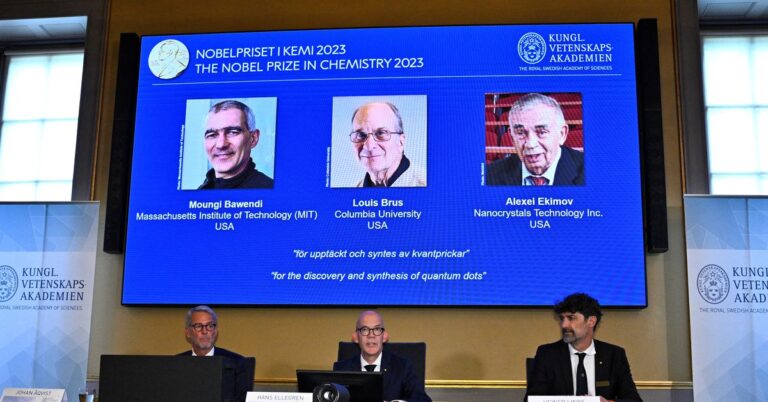STOCKHOLM, Oct 4 (Reuters) – Scientists Mungi Bawendi, Luis Brus and Alexey Ekimov have discovered that quantum dots are widely used today to create colors in flat screens and light-emitting diodes. He won the 2023 Nobel Prize in Chemistry for his discovery of the known collection of tiny atoms. (LED) lamps and devices that allow surgeons to see blood vessels within tumors.
The academy, which awarded the award, said the work of three U.S.-based scientists on quantum dots, which have the same size ratios as a football to the Earth, “adds color to nanotechnology.”
“The researchers believe that in the future they could contribute to flexible electronics, miniature sensors, thin solar cells, and encrypted quantum communications,” the academy said in a statement.
The more than 100-year-old award is awarded by the Royal Swedish Academy of Sciences and is worth 11 million Swedish crowns ($1 million).
Nobel Committee for Chemistry Chairman Johan Akvist said one of the “fascinating and unusual properties” of quantum dots is that the color of the light changes depending on the particle size, without changing the atomic structure.
Bawendi said she was “very surprised, sleepy, shocked, unexpected and very honored” to receive the award. Bruce said it was so unexpected that she ignored the first six calls she received from people trying to tell her the news.
Earlier Wednesday, the Academy appeared to share the names of the winners in error.
“It’s very unfortunate that the press release came out, but we still don’t know why it happened,” said Hans Ellegren, the academy’s executive director. He added that it does not influence the selection of winners.
The quantum dot technology that makes high-definition QLED TVs sold by Samsung (005930.KS), Sony (6758.T) or TCL (000100.SZ) possible traces its roots to Ekimov’s work in the early 1980s. .
“I never could have imagined that we could manufacture these things on such a large commercial scale,” Bawendi said at a press conference at the Massachusetts Institute of Technology (MIT), where he is a professor.
Ekimov was a pioneer who discovered that the color of glass changes depending on the size of the copper chloride molecules contained in it, and that subatomic energy is at work.
In a phone interview with Reuters, Ekimov, 78, who was born in the Soviet Union and later immigrated to the United States, marveled at the latest flat-screen technology, something he never imagined while working in the 1980s. “Remember TV back then!” he said with a laugh.
A few years later, Bruce expanded his research to microscopic particles suspended in liquids.
“This is a collaborative effort,” Mr. Brus said in an interview from his home in Hastings-on-Hudson, New York. “There’s no such thing as ‘Eureka’!” For a moment. “
In 1993, Bawendi revolutionized the production of quantum dots and improved their quality.
Among other applications, this research enables LEDs to shine more like natural sunlight, avoiding the bluish light that was previously shunned.
Mr. Brus is a professor emeritus at Columbia University, and Mr. Ekimov works at Nanocrystals Technology Inc., both in New York.
Brus was hired by AT&T Bell Labs in 1972, where he spent 23 years, devoting much of his time to nanocrystal research.
“It’s not that I’m a genius. I’m far from a genius,” Blass said. “But the important thing is to try to find problems that others don’t realize are important and aren’t working on.”
Born in Paris, Bawendi attended Bell Labs during summers as a student, where he met Bruce, who became his mentor. “It was a cauldron of energy and science,” Bawendi said.
He also talked about how he failed his first chemistry exam as a first-year undergraduate. “I got 20 out of 100. I was the lowest in my class. I thought, ‘Oh, this is it for me, what am I doing here?'” he said. Told.
The Nobel Prize in Chemistry is the third of this year’s awards, following the Medicine and Physics Prizes announced this week.
Established in the will of Swedish dynamite inventor and chemist Alfred Nobel, the prize has been awarded for achievements in science, literature, and peace since 1901.
While the Chemistry Prize is often overshadowed by the Physics Prize and famous winners such as Albert Einstein, Chemistry Prize winners include radioactivity pioneers Ernest Rutherford and Marie Curie, who also won the Physics Prize. , which includes many of the greats of science.
($1 = 11.0225 Swedish Crowns)
Reporting by Niklas Pollard, Simon Johnson and Johan Erlander in Stockholm, Jonathan Allen in New York and Ludwig Berger in Frankfurt.Additional reporting by Terje Solsvik in Oslo, Anna Ringstrom in Stockholm and Shannon Stapleton in Hastings-on-Hudson, New York; Editing by Alexandra Hudson
Our standards: Thomson Reuters Trust Principles.
